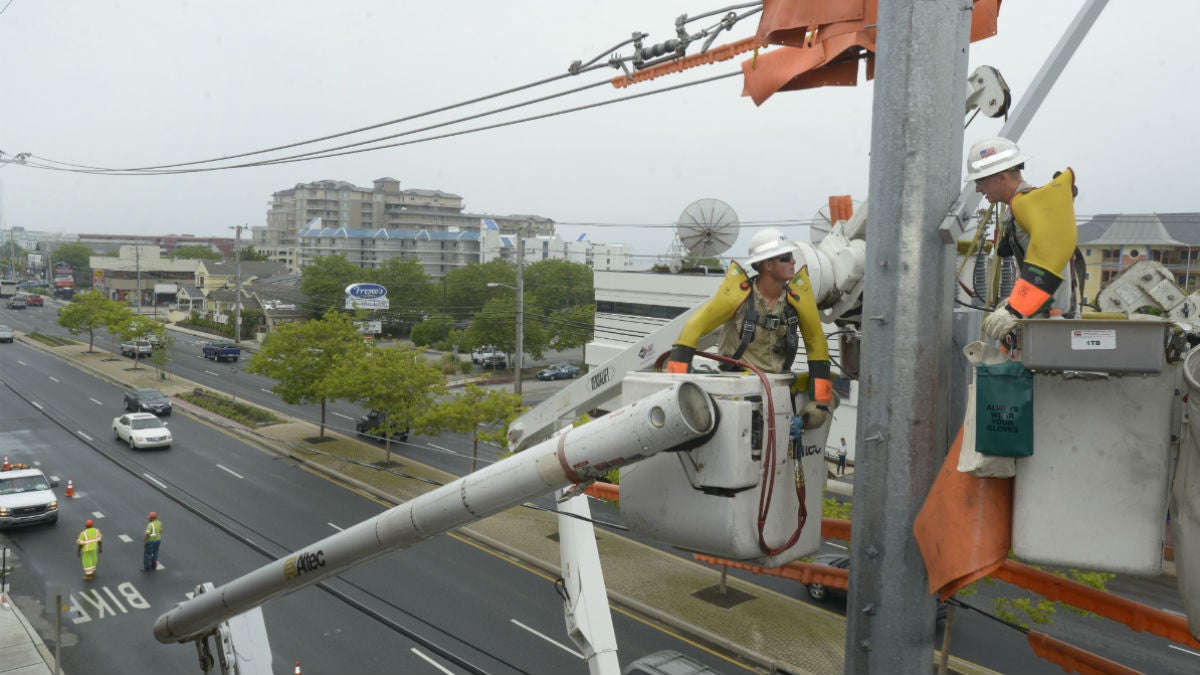Teach Me: utility lineman [VIDEO]

Linemen are pictured at work in this file photo. (Courtesy Delmarva Power)
When you think of dangerous, demanding jobs, what comes to mind?
Police officer? Fire fighter?
How about utilities worker?
While there may not be prime-time tv shows about lineman, according to the Bureau of Labor Statistics, the folks who install and repair electrical lines are actually more likely to die on the job than cops, firemen, and even construction workers.
And becoming a utility worker, well that’s not easy either.
I learned that the hard way during a day spent at Delmarva Power headquarters in Newark, Delaware. There, some of the veteran linemen put me through the first part of a two-day training course called the Pre Qualification Exercise (PQE).
The PQE is essentially pole-climbing 101. And every candidate must pass in order to be considered for employment. That may sound like a formality, but it isn’t. The veteran linemen who teach the course estimate about 70 percent of applicants don’t make it through.
“We’ve had that happen a lot where they’re climbing well, they’re doing a great job, their confidence level is really high. And then they have that one fall and everything changes,” says Jeff Ziemba, Delmarva’s distribution supervisor in the line department and my climbing guide for the day.
The PQE begins with what’s called a tailgate. Just like they would in the field, the linemen-in-training gather for a rundown of the job ahead. They go over potential hazards and ask questions.
Then, Ziemba introduces me to my equipment. I’m outfitted with a helmet, vest, protective goggles, and a seemingly endless web of belts and holsters. Finally, I step into my gaffes–short, metal spikes strapped to the sides of my boots. It is the gaffes that will allow me to climb the wooden utility poles in the Delmarva training yard–and stay attached to them once I’m airborne.
Ziemba shows me how the gaffes work. He demonstrates proper climbing form. I’m told to straddle the pole, pick one leg up high in the air, and then drive my right gaffe into the pole at a 30 degree angle. Then I’m to straighten my right leg and repeat the process with my left gaffe.
In the training scenario, I’m attached via carabiner to a back-up wire designed to break my fall. But in the real world, the gaffes are the only things that keep linemen attached to the pole. There’s no parachute. No safety net. One false step at a bad angle–or even a proper step into a patch of rotted wood–can send a lineman careening toward the ground.
It sounds dicey, but as I watch some of the veteran linemen demonstrate, it looks effortless. They glide up and down, appearing no more taxed than a tourist hiking a gentle mountain path.
I ready myself for the virgin climb, flush with confidence.
It doesn’t last long.
My first climb ends after about two seconds. Apparently I haven’t driven my gaffe into the wood with enough authority. My second climb follows a similar trajectory: step, slip, fall.
Finally, after some gentle reassurance from the vets, I start to ascend. For the next ten minutes I complete a series of pathetically slow climbs, never getting more than about five feet from the blessed ground. When I’m not nervously deciding whether to take my next step, I’m hugging the pole like a close relative.
Gradually, my confidence grows and I start to approach a white line on the pole about ten feet off the ground.
“Now where you’re at right now is a big transition period for us as instructors,” Ziemba tells me. “Because right there is where the human brain starts to realize if I fall now I can really hurt myself.”
This is the point, Ziemba says, where many turn back. Over the years he’s seen many a manly man defeated by this innocent strip of white spray-paint (the job attracts lots of former athletes, Ziemba says).
But not me! I climb upward. Grimacing, panting, I make it about 25 feet up the pole. It may not look impressive, but I’m satisfied. And tired.
Ziemba assures me that with proper climbing technique, linemen can handle spending up to 24 hours in a row out in the field. My screaming muscles think otherwise.
Mind you, all this is just step one. After this two-day intro, applicants have to complete an eight-week training course. Once they graduate, they can become apprentices on a utility crew, where they start as ground support. It can take another four years or so before they finally begin climbing in the real world.
But the biggest hurdle is still at the training yard, where applicants must face the pole and decide if they’ve got what it takes to hang in this high-flying profession.
“If they can’t get over that hump they’re just not gonna be successful,” says Ziemba. “They may have the physical body and presence to do that, but if they can’t overcome that mentality of the fear then they’re not gonna make it.”
WHYY is your source for fact-based, in-depth journalism and information. As a nonprofit organization, we rely on financial support from readers like you. Please give today.


